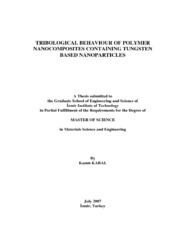Please use this identifier to cite or link to this item:
https://hdl.handle.net/11147/3996Full metadata record
| DC Field | Value | Language |
|---|---|---|
| dc.contributor.advisor | Tanoğlu, Metin | - |
| dc.contributor.author | Karal, Kazım | - |
| dc.date.accessioned | 2014-07-22T13:52:54Z | - |
| dc.date.available | 2014-07-22T13:52:54Z | - |
| dc.date.issued | 2007 | - |
| dc.identifier.uri | http://hdl.handle.net/11147/3996 | - |
| dc.description | Thesis (Master)--Izmir Institute of Technology, Materials Science and Engineering, Izmir, 2007 | en_US |
| dc.description | Includes bibliographical references (leaves: 81-83) | en_US |
| dc.description | Text in English; Abstract: Turkish and English | en_US |
| dc.description | xii, 83 leaves | en_US |
| dc.description.abstract | The use of nanostructured fillers in epoxy systems has a significant role on the development of thermosetting composites. Recent investigations on inorganic nanoparticles filled polymer composites reveal their significant potential in producing materials with low friction and/or high wear resistance. In the present study, epoxy nanocomposites and fiber reinforced polymer (FRP) composites were prepared with the addition of tungsten based nanostructured particles which are produced by mechanical alloying. The effects of the nanostructured additives on the tribological, mechanical and thermal properties of composite laminates and nanocomposites were investigated. Composite laminates with and without filler were manufactured by using hand lay-up technique and cured under compression. It was found that tungsten based particle loading has no significant effect on the flexural properties of the nanocomposites and the composite laminates, and the tensile properties of the nanocomposites. It was found that while the addition of 3 wt. % of nanoparticles increases the hardness values, it significantly improves the wear resistance of nanocomposites. Furthermore, the significant improvement on the wear resistance was observed with the addition of 3 wt. % W-SiC-C (24h mechanical milling) powder onto the surface of fiber reinforced epoxy. The worn surfaces were examined with scanning electron microscopy (SEM) and the results revealed that wear mechanisms are altered due to the presence of nanoparticles in the matrix. Differential scanning calorimetry (DSC) results showed that nanoparticles have no significant effect on glass transition temperatures (Tg) of nanocomposites. Incorporation of nanoparticles increased the thermo mechanical properties of nanocomposites and composite laminates; including the storage and loss modulus and Tg. | en_US |
| dc.language.iso | en | en_US |
| dc.publisher | Izmir Institute of Technology | en_US |
| dc.rights | info:eu-repo/semantics/openAccess | en_US |
| dc.subject.lcc | TA418.9.C6 K18 2007 | en |
| dc.subject.lcsh | Polymeric composites | en |
| dc.subject.lcsh | Nanocomposites (Materials) | en |
| dc.subject.lcsh | Tribology | en |
| dc.subject.lcsh | Nanoparticles | en |
| dc.subject.lcsh | Tungsten | en |
| dc.title | Tribological Behaviour of Polymer Nanocomposities Containing Tungsten Based Nanoparticles | en_US |
| dc.type | Master Thesis | en_US |
| dc.institutionauthor | Karal, Kazım | - |
| dc.department | Thesis (Master)--İzmir Institute of Technology, Materials Science and Engineering | en_US |
| dc.relation.publicationcategory | Tez | en_US |
| dc.identifier.wosquality | N/A | - |
| dc.identifier.scopusquality | N/A | - |
| item.languageiso639-1 | en | - |
| item.openairecristype | http://purl.org/coar/resource_type/c_18cf | - |
| item.fulltext | With Fulltext | - |
| item.cerifentitytype | Publications | - |
| item.openairetype | Master Thesis | - |
| item.grantfulltext | open | - |
| Appears in Collections: | Master Degree / Yüksek Lisans Tezleri | |
Files in This Item:
| File | Description | Size | Format | |
|---|---|---|---|---|
| T000664.pdf | MasterThesis | 18.7 MB | Adobe PDF |  View/Open |
CORE Recommender
Items in GCRIS Repository are protected by copyright, with all rights reserved, unless otherwise indicated.